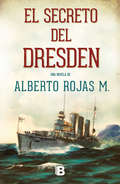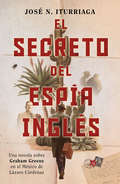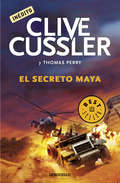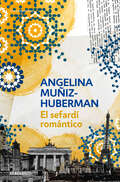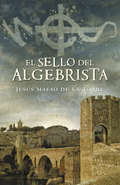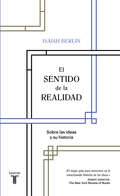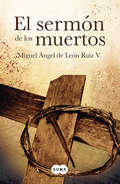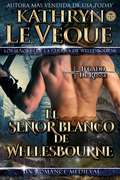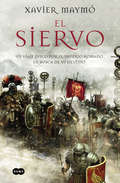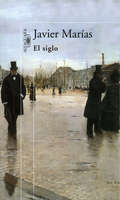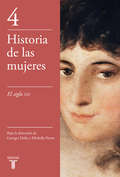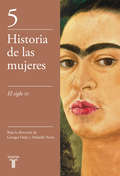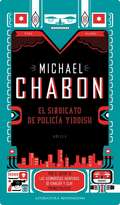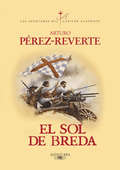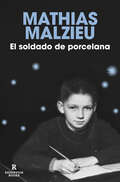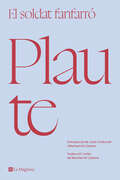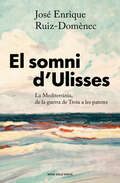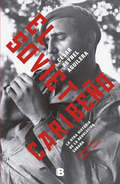- Table View
- List View
El secreto del dresden
by Alberto RojasLa búsqueda de uno de los tesoros más misteriosos que esconde el fondo del océano El 14 de marzo de 1915 el imponente crucero Dresden de la Marina Imperial Alemana fue hundido por su tripulación en aguas chilenas, en un desesperado intento por evitar su captura a manos de los británicos. Más de un siglo después,persiste aún la leyenda acerca de un tesoro fabuloso que el navío transportó por la costa atlántica de México, que nunca fue hallado. ¿Y si ese tesoro no se trataba de oro o joyas sino de un secreto capaz de alterar para siempre la historia de la humanidad? En este thriller histórico, Alberto Rojas convoca a desalmados magnates europeos, audaces reporteros chilenos, hackers de la Dark Web, ex soldados de elite e historiadores expertos en las grandes guerras, en una vertiginosa persecución por Europa y Sudamérica, para develar la otra historia de un navío fantasmal que reposa bajo las aguas de la bahía Cumberland, en el archipiélago de Juan Fernández. "El secreto del Dresden combina la intriga del thriller con la novela histórica. Ideal para lectores acostumbrados a relatos vertiginosos anclados en la historia reciente".
El secreto del espía inglés
by José de IturriagaUna novela sobre Graham Greene en el México de Lázaro Cárdenas México, 1934: Lázaro Cárdenas se confronta sin titubeos con las grandes potencias extranjeras y decreta la expropiación del petróleo, que afecta principalemnte a las compañías inglesas que controlan el negocio. En este contexto, el presidente conoce la llegada de un famoso escritor británico: Graham Greene, de quien se sabe además que es un férreo crítico de la cultura nacional. ¿Cuál será su verdadero interés al visitar el país? ¿Debe el gobierno preocuparse por el espionaje extranjero? Diego Santos, experto en asuntos de inteligencia y viejo amigo de Cárdenas, será el encargado de seguirle la pista al autor hasta averiguarlo. En esta apasionante trama, en la que se combinan con maestría el rigor histórico y las virtudes de las mejores novelas de espionaje, José N. Iturriaga perfila el retrato de un llamativo periodo de la historia de México, así como el de una de las figuras más relevantes de la literatura contemporánea: Graham Greene, el atormentado escritor católico que exploró todos los recovecos de la conciencia moral del ser humano.
El secreto maya (Las aventuras de Fargo #5)
by Thomas PerryEn esta quinta entrega de las aventuras del matrimonio de cazadores de tesoros, el descubrimiento de un ancestral libro maya desencadenará una terrible lucha para hacerse con sus secretos, en la que Sam y Remi Fargo se verán implicados. Sam y Remi Fargo se encuentran en la costa oeste de México cuando la noticia de los terribles efectos de un terremoto cerca de la frontera pone al matrimonio en marcha. Decididos a ayudar en todo lo que puedan, parten a toda velocidad con su yate hacia la zona afectada. Ya en las aldeas damnificadas de la costa llega a sus oídos la noticia de un pueblo indígena que se ha quedado aislado cerca del Volcán Tacaná. Sin dudarlo ni un segundo, los Fargo organizan una expedición de rescate. Pero durante la travesía Sam tropieza con lo que parece ser una tumba maya, aflorada de bajo tierra por causa del seísmo y que contiene, además, una urna sellada en cuyo interior se ha guardado durante siglos un manuscrito precolombino. Se trata de un hallazgo excepcional, de valor incalculable... y los saqueadores estarán dispuestos a todo por hacerse con él. Reseña:«Un magnífico entretenimiento para los fans de la aventura.»Booklist
El sefardí romántico: La azarosa vida de Mateo Alemán II
by Angelina Muñiz-HubermanLas hazañas, aventuras, desconciertos, altibajos, estafas, miserias, alegrías y sutiles erotismos de Mateo Alemán II, nuestro pícaro sefardí romántico, nos darán una visión alterna de la historia del siglo xx.Las andanzas del supuesto descendiente del autor del Guzmán de Alfarache lo llevarán de país en país: presenciará el surgimiento del fascismo en Italia y del nazismo en Alemania, para terminar peleando en la Guerra Civil española; después se unirá a los exiliados y arribará a tierras mexicanas.Para él, el amor y la amistad serán la luz dentro de la oscuridad que lo rodea. Al lado de personajes famosos como Stefan Zweig, Walter Benjamin, o de la farándula como Josephine Baker, se interrogará sobre el destino humano y sus ironías. Aprenderá a sobre- llevar las desgracias, pero un giro inesperado cambiará el sentido de su vida de manera definitiva.
El sello del algebrista
by Jesús Maeso de la TorreEn el siglo XIV, el joven algebrista Diego Galaz recorre el Mediterráneo en busca de su verdadero padre y su linaje. Su única pista lo llevará desde España hasta Oriente en una aventura que es un vívido fresco del mundo medieval y de la convivencia árabe, judía y cristiana en territorio hispánico. Huesca, S.XIV. En su lecho de muerte un monje entrega a su pupilo una pista para descubrir su verdadero padre y su linaje. El anciano monje herborista del monasterio de San Juan de la Peña llama a su lecho de muerte a Diego Galaz, maestro de álgebra educado en el convento, y le revela que su nacimiento oculta un gran secreto. En su agonía le entrega el eslabón que lo une a su familia: un enigmático anillo en el que aparecen buriladas las barras de Aragón y el símbolo de la inmortalidad del pueblo de Israel, emblema sagrado del linaje sacerdotal del Templo de Jerusalén. Galaz se lanza a desentrañar el enigma que esconde el anillo, aunque la búsqueda se revela más difícil de lo esperado: ninguna de las pistas son lo que parecen, pero a través de ellas inicia una aventura arriesgada que le lleva a los campamentos de almogávares del Pirineo, a la judería de Besalú y a Zaragoza, donde recibe un extraño presagio y conoce a la dama de sus sueños, la bella conversa Isabella Santángel. Desde Barcelona emprende rumbo a Oriente, ignorante de los letales peligros y de las situaciones extremas que le aguardan. La odisea de Diego Galaz es el hilo conductor de un vívido fresco del mundo medieval: las costumbres de los almogávares en la Atenas aragonesa, la Arabia Feliz, el País de los Aromas, las fabulosas Ciudades del Oro de las fuentes del Nilo, El Cairo, el mar Rojo, la etíope Lalibela, Alejandría y Sicilia. Con un gran despliegue de imaginación, vigor narrativo y sabiduría histórica, Jesús Maeso desvela los misterios de los algebristas de Alejandría y la vida de los místicos de las cuevas de Qumran, así como las intrigas de las cortes de Castilla y Aragón, a través de una trama subyugante y con escenas de gran intensidad que llevan al más insospechado desenlace.
El sendero salvaje del amor: Libro Uno (Norteamérica Salvaje #1)
by Dorothy WileyDos vidas. Un gran amor puesto a prueba por un traficante de esclavos despiadado y la aterradora naturaleza salvaje. Con el sueño de forjar una vida mejor, Stephen y Jane inician un viaje a través de la frontera Norteamericana en 1797 en busca de un lugar al que llamar hogar en una tierra de inimaginable belleza. Tejiendo un tapiz con hilos de historia, romance y aventuras, la épica novela de Dorothy Wiley nos sumerge en un asombroso y conmovedor relato de amor y supervivencia en una Norteamérica emergente. Con un coraje impertérrito y una audacia sin límites, Stephen Wyllie, junto con sus cinco hermanos, se adentra con valentía en aterradoras tierras vírgenes. Pero este formidable viaje de más de mil seiscientos kilómetros amenaza todo lo que es importante para Stephen y su esposa Jane Wyllie. El valor de él es imperturbable, la pasión de ella es profunda, pero esas tierras salvajes están repletas de terror. Stephen es un héroe que no retrocede, pero ¿será el amor de Jane, aquello que más valora en la vida, el precio a pagar por sus sueños? Esta fascinante historia lleva a los lectores a través de una heroica e impresionante búsqueda de tierras a través de un viaje de más de mil seiscientos kilómetros hasta llegar a las tierras vírgenes de Kentucky, un nuevo mundo para los valientes. Solo hay una cosa que Stephen desea más que nuevas tierras y es mantener a salvo a su esposa Jane y a sus jóvenes hijas. Pero necesita esas tierras para construir un futuro mejor para su familia y la frontera está abierta a la colonización en el nuevo estado de Kentucky. Tomar la decisión de partir no es fácil y Stephen sopesa cuidadosamente los riesgos antes de emprender lo que sabe que será un viaje peligroso. Una sólida combinación de aventura y acción, angustia y humor, romance y pasión, EL SENDERO SALVAJE DEL AMOR es el primer libro de la premiada serie de romántica Norteamérica Salvaje de la au
El sentido de la realidad: Sobre las ideas y su historia
by Isaiah BerlinTaurus recupera El sentido de la realidad, el libro más personal de uno de los principales pensadores liberales del siglo XX. ¿Cómo construir una sociedad decente?¿Por qué ciertas ideas aparentemente nobles y hermosaspueden alimentar las peores ideologías? Referente ineludible en la historia de las ideas, Berlin recorre magistralmente, en estos nueve ensayos, las ideas que han gobernado la historia europea durante los últimos tres siglos: nacionalismo, liberalismo y especialmente marxismo. Con el fin de extraer lecciones morales, Berlin se pregunta por qué los seres humanos tienden a admirar a hombres movidos por la ambición, los celos o la vanidad monomaníaca -incluidas figuras notables de la historia como Pedro el Grande y Napoleón-, y proporciona algunas respuestas, siempre reveladoras, en este estudio de las ideas. El sentido de la realidad incluye textos clave de quien ha sido considerado uno de los mejores ensayistas en inglés, y cubre un amplio abanico de temas: el realismo en la historia, naturaleza y el impacto del marxismo, la historia del socialismo, la radical revolución cultural llevada a cabo por los románticos, las nociones rusas de compromiso artístico, o la práctica y el origen del nacionalismo... Reseñas:«Este libro es indispensable para cualquiera que quiera comprender la historia de las ideas.»John Gray, The New York Times Book Review «El viejo zorro del liberalismo ofrece esta obra perspicaz. Es tan brillante a la hora de repensar el pasado como a la de transmitir su pensamiento.»Kirkus Reviews «Erudito pero no académico, se dirige al lector general, y habla con una energía tan contagiosa que nos arrastra a un territorio que nos parecía inaccesible, y se convierte en el mejor guía para movernos en la emocionante historia de las ideas.»Robert Darnton, The New York Review of Books «Si es posible elevar más una reputación ya tan notable, estos ensayos podrían lograrlo. Son textos de urbanidad, perspicacia, profunda erudición y gran elegancia literaria.»A.C. Grayling, Financial Times
El sentimiento más inesperado (Salón Selecto #Volumen 5)
by Bethany BellsUna joven convencida de que el amor la espera en otra parte. Un hombre dispuesto a cumplir una promesa, aunque eso suponga renunciar al amor. A lady Helen Bowman, hija del conde de Wallpole, le gusta leer novelas románticas y odia la mentira. Y cuando descubre que el hombre que desea su familia para ella es el individuo más falso que conoce, elabora un plan que volverá imposible semejante matrimonio. Lord Frederick Kerr, barón Wallace, ha dedicado su vida a la historia y a viajar, pese a la fama de juerguista que le ha dado su gran amistad con el Club de los Benditos. No está interesado en debutantes, y menos en Helen, a la que considera una niña mimada, pero la promesa hecha a su padre en el lecho de muerte le obliga a cortejarla, y está dispuesto a cumplirla. Claro que, para su desgracia, no ha contado con la decisión y el ingenio de lady Helen.
El sermón de los muertos
by Miguel Ángel de León Ruiz VelascoA finales de la década de los veinte, mientras las huellas sangrientas de la Revolución seguían frescas, el país volvió a cimbrarse con la guerra cristera.Desde un poblado marcado por las advertencias del México rural, el protagonista de esta historia hace el recuento de su propia vida revelando cómo se sumó al ejército cristero, prácticamente obligado por el sacerdote de su pueblo. La crueldad y la dureza no se hacen esperar. Él y sus compañeros asesinan a unos arrieros sin saber que son aliados de su causa, por lo que estarán a punto de ser linchados. Así da comienzo su travesía definida por la violencia, la manipulación política, el fanatismo religioso, el sexo y la culpa.El sermón de los muertos retrata con precisión la cristiada, en donde se enfrentaron el gobierno y los grupos armados controlados por la iglesia. Pero no lo hace a través de los personajes más visibles en la historia oficial, sino desde la perspectiva de la leva, el hombre común, los combatientes anónimos que fueron los reales protagonistas de uno de los episodios más devastadores de nuestra historia.
El sermón de los muertos
by Miguel Ángel de León Ruiz VelascoA finales de la década de los veinte, mientras las huellas sangrientas de la Revolución seguían frescas, el país volvió a cimbrarse con la guerra cristera. A finales de la década de los veinte, mientras las huellas sangrientas de la Revolución seguían frescas, el país volvió a cimbrarse con la guerra cristera. Desde un poblado marcado por las advertencias del México rural, el protagonista de esta historia hace el recuento de su propia vida revelando cómo se sumó al ejército cristero, prácticamente obligado por el sacerdote de su pueblo. La crueldad y la dureza no se hacen esperar. Él y sus compañeros asesinan a unos arrieros sin saber que son aliados de su causa, por lo que estarán a punto de ser linchados. Así da comienzo su travesía definida por la violencia, la manipulación política, el fanatismo religioso, el sexo y la culpa. El sermón de los muertos retrata con precisión la cristiada, en donde se enfrentaron el gobierno y los grupos armados controlados por la iglesia. Pero no lo hace a través de los personajes más visibles en la historia oficial, sino desde la perspectiva de la leva, el hombre común, los combatientes anónimos que fueron los reales protagonistas de uno de los episodios más devastadores de nuestra historia.
El señor Blanco de Wellesbourne: ¿Ganará el amor o el deber?
by Kathryn Le Veque1485 d. C. - Adam Wellesbourne y sus cuatro hijos, Matthew, Mark, Luke y John, constituyen la casa más temida al servicio de Richard III. El hijo mayor de Adam, Matthew, se ha ganado una reputación tan influyente que en toda Inglaterra es conocido como El Señor Blanco de Wellesbourne. En la víspera del campo de la Batalla de Bosworth, Matthew se ve forzado a un matrimonio por contrato que ha estado evitando durante diez años. No desea casarse con Lady Alixandrea Terrington St. Ave, pero su padre insiste. La dama viene con una dote de 400 luchadores, lo más importante en estos tiempos de guerra. Pero algo extraño le sucede a Matthew en el momento en que conoce a su futura esposa; él realmente se siente atraído por ella. Lady Alixandrea es hermosa, inteligente y amable. Pero también, sin saberlo, está atrapada en un juego mortal de política. De repente, un matrimonio simple se convierte en una casualidad mortal. A medida que las fuerzas para el Rey Richard y Henry Tudor avanzan hacia la batalla que decidirá el futuro de Inglaterra, Matthew se distrae con la mujer con la que nunca quiso casarse. En este mundo donde la política de los hombres rivales que compiten por el trono controla la fortuna de una nación, El Señor Blanco de Wellesbourne se debate entre la vida inesperada que nunca pensó tener y la vida en guerra que siempre había conocido. ¿Lo ganará la encantadora Alixandrea o el rey Richard?
El siervo
by Xavier MaymóUna magistral novela histórica ambientada en el Imperio Romano. El destino de tres hermanos y un sirviente entre Tarraco, Roma y Jerusalén en el advenimiento del cristianismo. «Aún hoy se narra la leyenda de aquellos íberos que, formando parte de la guardia personal de Poncio Pilato, acabaron crucificando al hombre que los salvó.»Siglo I d.C. Cerca de Tarraco una familia romana crece en un lugar paradisíaco: la Villa de Semma. El padre y amo de todo y de todos, Valerius, un hombre culto y poderoso, planifica con todo detalle un futuro brillante para sus hijos. La vida, no obstante, dispondrá sus deseos de manera muy distinta, haciendo que los caminos de los protagonistas acaben confluyendo en un destino que nadie podía imaginar. De Tarraco a Jerusalén, pasando por las Galias y Roma, Servio, un guerrero íbero excepcional, protector de la familia, forjará una amistad indestructible con tres hermanos romanos nacidos en Hispania: Menandro, el primogénito de Valerius; la frágil y bella Silvia, y Licino, mudo y deforme, pero de gran inteligencia, quien acabará escribiendo la historia durante sus años de vejez. La fuerza de los protagonistas y su estrecha relación les permitirá superar las dificultades de un crecimiento personal que les llevará, con la ayuda del Jesús más humano, a encontrar su propia paz en tierras lejanas. Críticas:«El siervo es una novela para disfrutar. Su narración detallista y fluida del día a día en la Hispania y la Judea de la Roma Imperial, y los valores y las motivaciones de sus personajes convierten al lector en un compañero de viaje privilegiado de la vida de Servio y el resto de protagonistas.»Miquel Penella, CEO RLJ Entertainment, Washington D.C. «Con esta novela el lector tiene la clave de dos imperios: uno tangible, el romano, y otro intangible, la esencia humana. Leyéndole vives un viaje apasionante por las provincias de Roma en la mejor compañía posible y, como ocurre en todos los grandes periplos, vuelves a casa siendo mejor persona. ¡Un bestseller!»Marta Rey, abogada, La Seu d#Urgell «Esta es una novela escrita con admiración y respeto hacia dos ejes fundamentales de nuestra identidad: la romanización y la fe cristiana. La aventura vital de Servio de Semma permite recorrer las grandes cuestiones de la humanidad. Esta historia de historias transmite la esencia del algunas reflexiones que resultan fundamentales.»Padre Ignasi M., prior del Monasterio de Montserrat
El siglo
by Javier MaríasUna novela que se adentra en los mecanismos de la delación y la supervivencia, del dominio y la traición de los semejantes, y que fue, durante mucho tiempo, una de las preferidas de su autor. Sentado junto a una ventana con vistas a un lago cuyas aguas indefinidas, letárgicas, pusilánimes e indecisas le parecen fiel imagen de aquellos que, esperando su muerte, lo rodean en su retiro, el juez Casaldáliga ya no recuerda aquella frase que su padre le repetía: «Has de tener bien presente que un hombre no es nada sin un destino». Un destino que él buscó durante mucho tiempo, hasta que, en 1939, al regresar después de un exilio de tres años en Lisboa, vio claro que el final de la guerra le brindaba una oportunidad para decidir no sólo su destino, sino también el de sus semejantes. De El siglo se ha dicho:«Las oraciones, a veces largas, y parcas en diálogo, comunican el sentido del tiempo, del siglo, que a su vez viene a ser no sólo el siglo en que vive Casaldáliga, en que vivimos nosotros, sino El siglo, el mundo, la vida.»J. H. Abbott, ABC
El siglo XIX: El siglo XIX (Historia de las mujeres #Volumen 4)
by Georges DubyEsta obra busca analizar cómo las relaciones de los sexos condicionan la evolución de las sociedades y la necesidad de que las mujeres encuentren, al fin, su espacio propio. Esta Historia de las mujeres responde a la necesidad de ceder la palabra a las mujeres. Alejadas, desde la Antigüedad, del escenario donde se enfrentan a los dueños del destino, reconstruir su historia significa describir su lento acceso a los medios de expresión y su conversión en persona que asume un papel protagonista. Este análisis implica, asimismo, que las relaciones entre los sexos condicionan los acontecimientos, o la evolución de las sociedades. No se buscan conclusiones tajantes sino que las mujeres encuentren, al fin, su espacio propio. Tomando la periodización habitual y el espacio del mundo occidental, esta obra se divide en cinco volúmenes independientes pero complementarios. Este cuarto volumen estudia el nacimiento del movimiento feminista en el marco de las revoluciones económicas y sociales del siglo X|X.
El siglo XX: El siglo XX (Historia de las mujeres #Volumen 5)
by Georges DubyEsta obra busca analizar cómo las relaciones de los sexos condicionan la evolución de las sociedades y la necesidad de que las mujeres encuentren, al fin, su espacio propio. Esta Historia de las mujeres responde a la necesidad de ceder la palabra a las mujeres. Alejadas, desde la Antigüedad, del escenario donde se enfrentan a los dueños del destino, reconstruir su historia significa describir su lento acceso a los medios de expresión y su conversión en persona que asume un papel protagonista. Este análisis implica, asimismo, que las relaciones entre los sexos condicionan los acontecimientos, o la evolución de las sociedades. No se buscan conclusiones tajantes sino que las mujeres encuentren, al fin, su espacio propio. Tomando la periodización habitual y el espacio del mundo occidental, esta obra se divide en cinco volúmenes independientes pero complementarios. Este quinto y último volumen analiza la incorporación difinitiva de la mujer a la sociedad tras los cambios irreversibles provocados por la Primera y la Segunda Guerra Mundial.
El silbido del arquiero
by Irene Vallejo«Una novela breve que dialoga entre épocas, entre exiliados y vidas que recomienzan, entre dioses y hombres. En términos del cine contemporáneo, El silbido del arquero es el remake polifónico de un clásico, escrito con prosa expresiva y muy cuidada, que nos brinda pasajes profundos.» -Jaime Panqueva Luego del asedio de Troya, obligado a huir para sal Luego salvar a su familia, el derrotado héroe Eneas recibe una visión sobre el futuro de su casta. Acompañado de un puñado de sobrevivientes, se embarca hacia lo desconocido y naufraga en Cartago, donde es bien recibido por la reina Elisa y puede, al fin, atisbar la redención de su estirpe. Unos siglos más tarde, el poeta Virgilio recibe del emperador Augusto la encomienda de narrar la gloriosa historia de Roma , enraizada en aquella primera aventura de Eneas. Indeciso por la forma de llevar a cabo esta tarea, el poeta se pasea por la ciudad en busca de la inspiración, incapaz de ignorar la miseria que se oculta detrás del capaz mármol pulido de sus calles. El mito, la historia, la aventura, el romance y la guerra se entrecruzan en esta novela coral para recordarnos que el pasado está imbricado en las fibras del presente. Irene Vallejo da muestras de su erudición y su talento narrativo con cada capítulo, y ejerce un hipnótico llamado a sus lectores para mirar con ojos siempre nuevos las lecciones que el pasado tiene para ofrecer.
El silencio de las olas
by Ángela BanzasUn sueño recurrente y perturbador. Un misterioso camafeo y una mujer en busca de respuestas. Un secreto silenciado durante años rompe el rumor de las olas Adela Roldán, casada y con un hijo, lleva una apacible vida en familia salvo por una pesadilla recurrente que la perturba desde que era solo una niña. En ella ve cómo una joven es asesinada en presencia de su hija pequeña. Cuando despierta no recuerda nada más, hasta que una noche identifica el nombre del pueblo en el que ocurre todo: Vilar de Fontao, en Galicia. Decide viajar hasta allí y comprobar si la casa donde tiene lugar el horrible crimen existe. Lo que Adela desconoce es que, en realidad, emprenderá un viaje de más de cien años que la llevará desde un pazo en la Costa da Morte hasta la ciudad de Santiago de Compostela. Un viaje en el que perseguirá descubrir la verdad sin saber que se acerca a un secreto que unos intentan desvelar y que otros quieren preservar. Haciendo gala de un estilo lleno de resonancias e imágenes evocadoras, Ángela Banzas construye con maestría una novela que conecta la historia de varias generaciones de mujeres que deberán sobreponerse a la adversidad, a la traición, al dolor y al miedo, sin dejar de luchar con pasión por aquello en lo que creen en unos tiempos marcados por el clasismo rural, el hambre y la guerra, los bandos, la desconfianza y la muerte. «Aprende a amar tu destino. Cuando otros vean lluvia y la repudien, tú sonríe a la tierra agrietada y mortecina y espera la simiente que crecerá mañana. Sé paciente y perservera, pues en la oscuridad la luz brilla con más fuerza».
El sindicato de policía Yiddish
by Michael ChabonEl sindicato de policía yiddish imagina una historia alternativa en la que, durante más de sesenta años, los judíos refugiados y sus descendientes han vivido tranquilamente en el distrito federal de Sitka, un espacio temporal dependiente de Estados Unidos, en Alaska, en el que los judíos han residido en paz. Sin embargo, el sueño de «un hogar para los judíos» parece llegar a su final, y una vez más la Historia los arrastra a un destino incierto. El asesinato de un carismático miembro de la comunidad judía servirá para poner de manifiesto las poderosas fuerzas ocultas que manejan los habitantes de Sitka, así como la capacidad analítica del fabuloso detective Meyer Landsman.Rabinos que se convierten al crimen, delincuentes que creen en Dios y el detective de homicidios Meyer Landsman, que solo cree en su botella... La nueva y original novela del Premio Pulitzer por Las asombrosas aventuras de Kavalier y Klay ha vuelto a conquistar a la crítica internacional.«Una de las mejores novelas de historia alternativa junto a El hombre en el castillo de Philip K. Dick, La conjura contra América de Philip Roth o Patria de Robert Harris.»Rodrigo Fresán, Qué leerTraducción de Javier Calvo.
El sol de Breda (Las aventuras del capitán Alatriste #Volumen 3)
by Arturo Pérez-ReverteEn esta tercera entrega de «Las aventuras del capitán Alatriste» se escenifican las batallas y el asedio de la ciudad de Breda en 1625 por los tercios españoles en Flandes. Flandes, 1625. Alistado como mochilero del capitán Alatriste en los tercios viejos que asedian Breda, Íñigo Balboa es testigo excepcional de la rendición de la ciudad, cuyos pormenores narrará diez años más tarde para un cuadro famoso de su amigo Diego Velázquez. Siguiendo a su amo por el paisaje pintado al fondo de ese cuadro, al otro lado del bosque de lanzas, veremos a Íñigo empuñar por primera vez la espada y el arcabuz, peleando por su vida y la de sus amigos. Estocadas, asaltos, batallas, desafíos, encamisadas, saqueos y motines de la infantería española, jalonarán su camino a través de un mundo devastado por el invierno y por la guerra. «Al lento batir de los tambores, las primeras filas de españoles movíanse hacia adelante, y Diego Alatriste avanzaba con ellas, codo a codo con sus camaradas, ordenados y soberbios como si desfilaran ante el propio rey. Los mismos hombres amotinados días antes por sus pagas iban ahora dientes prietos, mostachos enhiestos y cerradas barbas, andrajos cubiertos por cuero engrasado y armas relucientes, fijos los ojos en el enemigo, impávidos y terribles, dejando tras de sí la humareda de sus cuerdas de arcabuz encendidas...»
El soldado de porcelana
by Mathias MalzieuCon la conmovedora historia de Mainou, Mathias Malzieu ha conquistado de nuevo a los lectores franceses, firmando una novela aclamada unánimemente por la crítica de su país. «Con pudor y emoción, Malzieu se pone en la piel de su propio padre, su soldado de porcelana, en esta novela divertida y tierna, sensible y melancólica, que suena siempre a verdad».Livres Hebdo Francia, verano de 1944. Con nueve años, Mainou acaba de perder a su madre mientras daba a luz a su hermana pequeña. El compungido padre se ve obligado entonces a enviar a Mainou a Lorena, con su abuela, al otro lado de la línea de demarcación, escondido en un carro de heno. Allí, en la granja familiar, tratará de retener los últimos suspiros de su infancia mientras la realidad lo empuja a evadirse: el miedo, la pena, la guerra. Junto a esa familia que aún no conocía, y a los misteriosos sucesos que los rodean, el niño se confía a la imaginación para atravesar el duelo y sobrevivir a los últimos meses de la Segunda Guerra Mundial. Con El soldado de porcelana, Mathias Malzieu le ha escrito una carta de amor a su padre que es a la vez un homenaje universal, una novela que narra los acontecimientos de su vida con la honestidad exacta para situarnos a la altura de los años cruciales, cuando todo está por definir. La crítica ha dicho:«Como suele ocurrir con Mathias Malzieu, los fantasmas no llevan sábanas blancas: son solamente recuerdos que aguardan para perseguirnos [...]. Una historia íntima y conmovedora».Le Figaro «Mathias Malzieu no escribe bien, escribe en estado de gracia; es como si fuera un niño crecido que ha hecho un pacto ateo con las estrellas. Sabe ver el polvo de lossueños que se esparce por el mundo y que revela, de manera casi fotográfica, la poesía de cada momento».Le Journal du Dimange «Una novela cariñosa e irresistible sobre la infancia de su padre. [...] Mathias Malzieu tiene el don de transformar las cosas serias en burbujas de poesía».Elle«Una historia que sabe proporcionarnos una alegría en cada página con sus expresiones revoltosas que parecen hilvanadas en el aire. ¡Y qué retrato lúdico de la infancia!»Le Parisien «El mundo de la infancia se evoca en estas páginas con una modestia abrumadora.[...] Páginas límpidas, inteligentes y sutiles».Le Provence«Mathias Malzieu [es] un mago de la narración. [...] Su arte consiste en contar una historia tierna poniéndose en la piel de un niño. Entre la delicadez y la poesía, nos convertimos en ese niño con un gran corazón. Encontramos aquí la esencia de Mecánica del corazón que tanto nos enamoró en su momento».Le Soir «lanovela más íntima de Mathias Malzieu, que combina el humor y la poesía para rememorar la infancia de su padre».Tandem «Una hermosa novela».Midi Libre «Sensible y precisa [...]. Mathias Malzieu, el travieso, ha encontrado el tono adecuado mezclando un humor desenfadado con imágenes oníricas».La Libre Belgique (Bélgica)«La guerra vista desde el punto de vista de un niño, descrita con una escritura poética: esta novela es de una belleza deslumbrante».Ciné Télé Revue (Bélgica) «Una verdadera oda a la perseverancia y al amor»La Côte (Suiza) «Un homenaje conmovedor. [...] Es un placer descubrir a Mathias Malzieu en este nuevo registro».Metro (Bélgica)
El soldat fanfarró
by PlauteEl soldat pagat de sí mateix i l’esclau murri còmplice del seu amo, protagonistes d’aquesta obra, són dos dels caràcters de Plaute amb més influència en la comèdia europea de tots els temps. A Efes, Pirgopolinices, soldat fanfarró i vanitós, ha segrestat l’amant de Plèusicles, Filocomàsia. Per alliberar-la, Palestrió, esclau de Plèusicles, li para una trampa: fa veure que la cortesana Acrotelèucia, que fingeix ser l’esposa del veí ancià del soldat, Periplectomen, se n’ha enamorat perdudament de Pirgopolinices. Aquest, convençut d’haver fet una bona conquesta, es desempallega de Filocomàsia. Mentrestant, Periplectomen, fingint indignació per la gosadia del soldat, li prepara una bona pallissa.
El somni d'Ulisses: La Mediterrània, de la guerra de Troia a les pasteres
by José Enrique Ruiz-DomènecLa Mediterrània, el mar de la història La Mediterrània és un mar aparentment plàcid sobre el qual s'alcen sovint núvols negres, un lloc de trobada i alhora de conflictes, bressol dels mites clàssics i de les grans religions monoteistes, escenari de l'eclosió d'algunes de les creacions de la humanitat més enlluernadores i camp de batalla de guerres terribles. Amb una amenitat extraordinària, José Enrique Ruiz-Domènec construeix un retrat elegant d'aquest món mediterrani, des de l'Antiguitat clàssica fins als nostres dies, que integra idees i esdeveniments, figures històriques i literàries, intrigues polítiques i passions humanes, obres d'art i llibres d'una biblioteca universal del coneixement humà. De la mort de Sòcrates a Carlemany, de Marco Polo a Napoleó i als savis d'Egipte, de Trieste a Israel, de la Barcelona olímpica a la guerra dels Balcans, El somni d'Ulisses és la gran obra d'un mestre de la historiografia que, després de quaranta anys d'estudi sobre la Mediterrània i de diversos libres d'èxit, presenta la síntesi definitiva sobre una civilització que ha marcat de forma indeleble el curs de la historia al llarg de tres mil anys. Amb una narració fascinant, un veritable regal per als sentits, l'autor ofereix una reflexió il·luminadora sobre la importància del llegat mediterrani en la cultura mundial, des de la guerra de Troia, que inspirà la poesia èpica d'Homer, fins a les pasteres que avui arriben a la costa i que són la imatge de les nostres pitjors decisions sobre el futur. Un llibre d'història per entendre el present i pensar el futur.
El sonido de los sueños: Y otros ensayos sobre música
by Diego FischermanEnsayos sobre música clásica y popular e interpretación musical, escritos magistralmente por Diego Fischerman, uno de los mejores críticos culturales de la Argentina. El extraño destino del hombre que grabó por primera vez Las cuatro estaciones de Vivaldi, el Oeste psicodélico de Ennio Morricone, gitanos en Europa y rusos en México, Liszt, Victor Hugo y la verdadera Carmen, el clavecinista que cometió el error de enamorarse y acabó como misionero en un virreinato perdido. También Billie Holiday, la comedia de Broadway -que nada tenía de comedia- y la sinfonía que Mozart pensó como comedia, el encuentro entre William Burroughs y Ornette Coleman, los sonidos del mar, Let it be y el arte de lo incompleto, Sandro, Ginastera, Paul Desmond, Chet Baker y los misterios de Miles Davis. Y también algunas marcas personales: María Elena Walsh, Luis Alberto Spinetta. En esta serie de ensayos breves, Diego Fischerman enhebra verdaderas joyas sobre música. Es decir, sobre el sonido: la sensación o la impresión producida en el oído por un conjunto de vibraciones que se propagan en un medio elástico, y que, como el aire, pueden ser la levedad o la espesura de un sueño.
El soviet caribeño: La otra historia de la Revolución Cubana
by César Reynel AguileraLa verdadera historia de la Revolución Cubana a partir de las relaciones ocultas, y durante mucho tiempo subestimadas, entre los hermanos Castro y el Partido Comunista de Cuba, relatada por César Reynel Aguilera, hijo de dos reconocidos combatientes de la lucha clandestina contra la tiranía de Fulgencio Batista. El soviet caribeño describe la historia de la Revolución Cubana a partir de las relaciones ocultas, y durante mucho tiempo subestimadas, entre los hermanos Castro y el Partido Comunista de Cuba - Partido Socialista Popular (PCC-PSP). Para explicar esas relaciones, el autor se remonta a los orígenes del PCC-PSP y plantea, por primera vez en la historiografía cubana, la coexistencia de dos organizaciones paralelas: un partido político de corte tradicional y un núcleo central de inteligencia soviética (NCIS). A pesar de haber estado estrechamente relacionadas, esas dos organizaciones tuvieron, en marcadas ocasiones, objetivos que diferían radicalmente dentro del contexto cubano. Cada vez que eso sucedió se impuso, como una norma inviolable, la opinión del NCIS. A fines de la década de los 40, el Partido, dañado en su popularidad y capacidad de liderazgo a consecuencia de sus errores -entre los que resalta su fallida alianza con el tirano Batista entre 1938 y 1944-, pero extraordinariamente bien posicionado dentro de las estructuras políticas y militares del Estado cubano de la época, decidió utilizar a Fidel Castro como el caballo de Troya de los comunistas cubanos. Para que esa utilización pudiera llegar a buen término, era necesario mantener la relación entre comunistas y castristas en el más alto secreto. Es por eso que el vínculo entre Fidel Castro y el PCC-PSP nunca fue con el Partido como tal, sino con el NCIS. Esa dualidad explica, entre otras cosas, la aparente contradicción entre la proyección pública del Partido con respecto a Fidel Castro -en ocasiones crítica- y las acciones de un grupo relativamente reducido de hombres y mujeres que protegieron y asesoraron al castrismo desde sus inicios. Después del triunfo de la revolución, fue el NCIS el encargado de organizar la seguridad personal de los hermanos Castro y los servicios de inteligencia del castrismo. Eso le permitió penetrar los puestos más importantes de la maquinaria del poder castrista y empezar, desde enero de 1959, el llamado proceso de radicalización revolucionaria. No es casual, entonces, que los miembros del NCIS aparezcan involucrados, siempre desde las sombras y a distancia, en eventos de la Revolución cubana tan importantes como la crisis de octubre, el juicio de Marquitos, la muerte del Che Guevara, el inicio de las aventuras africanas del castrismo y, eventualmente, la guerra en Angola.
El sueño de Akala
by Francisco Panera RodríguezMiles de personas entran y salen todos los días de Bilbao a través del túnel de Malmasín. Pocas sospechan que sobre sus cabezas, en la cima de ese monte situado entre Arrigorriaga y Basauri, se hallan los restos de un poblado fortificado de la Edad de Hierro, el período inmediatamente anterior a la época romana. Francisco Panera se ha inspirado en esos restos para escribir El sueño de Akala, una novela en la que caristios y autrigones, dos de los pueblos que, como várdulos, berones o vascones, habitaron hace 2.000 años lo que hoy es territorio vasco, mantienen un pleito secular por el control de una posición estratégica en torno a un río que bien pudiera ser el Nervión. Los romanos deciden intervenir en la disputa y lo hacen como juez y parte. En ese marco se desenvuelven los personajes de esta novela, muchos y variados, desde un chico capaz de vislumbrar el futuro, a una anciana marginada por los suyos acusada de hechicería, pasando por una mujer que acaba de enviudar en extrañas circunstancias o un veterano tribuno romano cuya convicción en las bondades del Imperio está a punto de resquebrajarse. El sueño de Akala es ante todo una trepidante novela de aventuras, repleta de lances y giros inesperados. Pero, como toda buena novela, no renuncia a abordar cuestiones fundamentales, como el amor, la ambición, la lealtad o la libertad.
